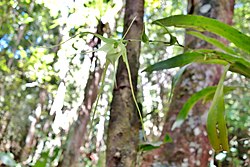| Aeranthes antennophora | |
|---|---|
 | |
| Scientific classification | |
| Kingdom: | Plantae |
| Clade: | Tracheophytes |
| Clade: | Angiosperms |
| Clade: | Monocots |
| Order: | Asparagales |
| Family: | Orchidaceae |
| Subfamily: | Epidendroideae |
| Genus: | Aeranthes |
| Species: | A. antennophora |
| Binomial name | |
| Aeranthes antennophora H.Perrier, 1938 | |
Aeranthes antennophora is a species of orchid native to Madagascar. [1]
